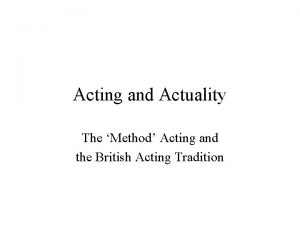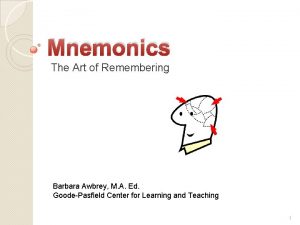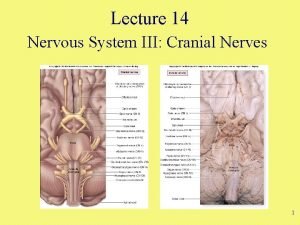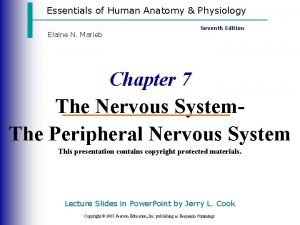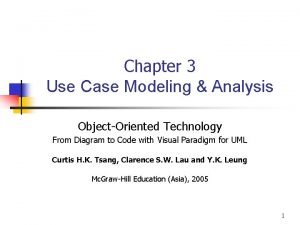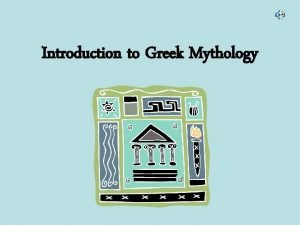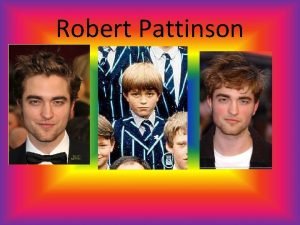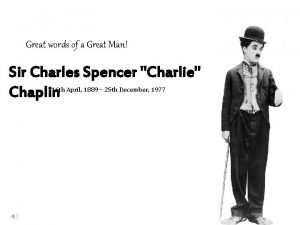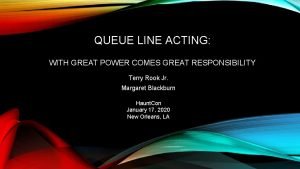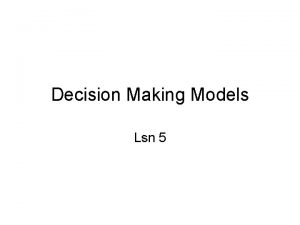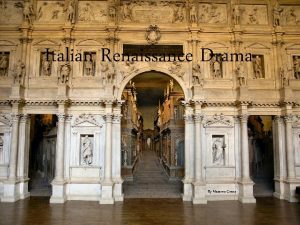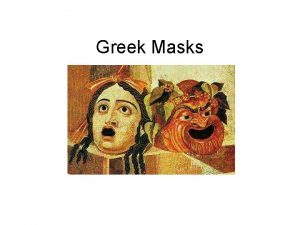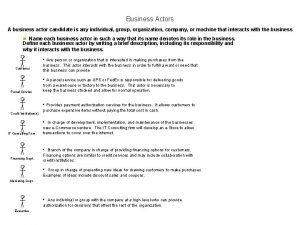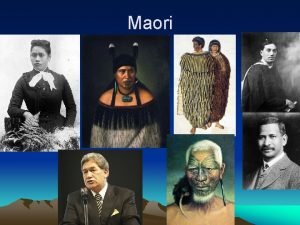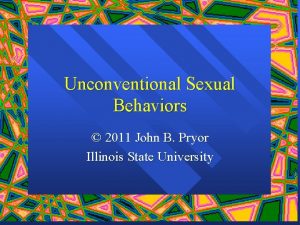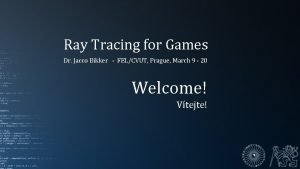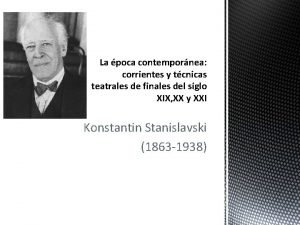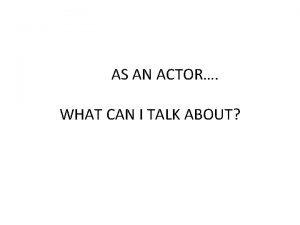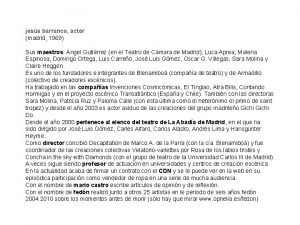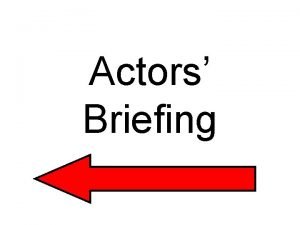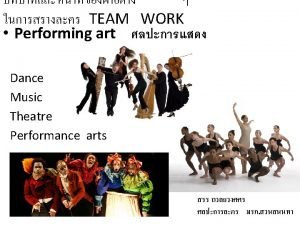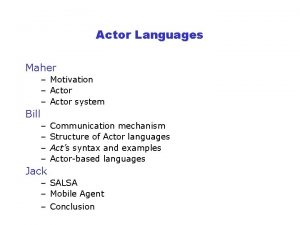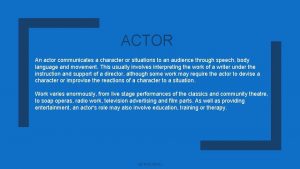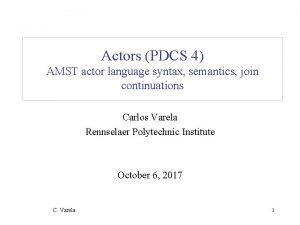Actors and Acting Very occasionally an actor on
































































- Slides: 64

Actors and Acting Very occasionally an actor on the stage appears to be exactly the same as somebody in ordinary life. But usually the actor is not the same as he or she is in real life.

Actors and Acting Very occasionally an actor on the stage appears to be exactly the same as somebody in ordinary life. But usually the actor is not the same as he or she is in real life.

Actors and Acting Very occasionally an actor on the stage appears to be exactly the same as somebody in ordinary life. But usually the actor is not the same as he or she is in real life. In the film, United 93, the FAA Operations Manager, Ben Sliney, played himself.

Actors and Acting Very occasionally an actor on the stage appears to be exactly the same as somebody in ordinary life. But usually the actor is not the same as he or she is in real life. In the film, United 93, the FAA Operations Manager, Ben Sliney, played himself. But this is unusual.

Actors and Acting Very occasionally an actor on the stage appears to be exactly the same as somebody in ordinary life. But usually the actor is not the same as he or she is in real life. He or she often does some very unlikely things in the course of two hours such as solving a daunting puzzle, enduring appalling physical punishment, or experiencing a wonderful romance.

Actors and Acting

Actors and Acting is, to some degree, an instinctive art. As children, we all imitated others and, in our make believe, we would become heroes and heroines.

Actors and Acting But, although acting is often instinctual, it is also one of the most demanding of arts. Constant training is necessary, for unless the voice and body are kept fit, the actor will not be able to realize what he or she wishes to do in a role.

Actors and Acting What Goes Into Making an Actor? 1. There are great physical, emotional and mental strains placed on an actor. 2. Although acting can appear to be a glamorous profession, it also requires collaboration with many other people and the making of many important choices.

Actors and Acting What is an Actor? 1. Acting in theatre is not the same as acting for film or television. Neither of these “lens media” involves performance in front of an audience that has come to witness a complete performance.

Actors and Acting What is an Actor? 1. Even a TV sitcom with a live audience can be edited before transmission and the director always has a choice of several images for any moment recorded. The same is true for film.

Actors and Acting If and actor or a director does not like a scene, he or she can simply do it again, but with a live audience, there are no second takes.

Actors and Acting What is an Actor? 1. Only in theatre is an actor in live contact with an audience and able to communicate directly a sense of risk, play, conflict, amazement, and exposure. The acting is open and fresh.

Actors and Acting Actor as Instrument – Anyone who works professionally as an actor must work on his or her gifts and talents:

Actors and Acting Actor as Instrument – Anyone who works professionally as an actor must work on their gifts and talents: 1. Voice and Speech -

Actors and Acting Actor as Instrument – Anyone who works professionally as an actor must work on their gifts and talents: 1. Voice and Speech – The voice must trained so that it is worth listening to. The aspiring actor must practice so that he/she can manage tempo, rhythm, phrasing and cadence.

Actors and Acting Actor as Instrument – Anyone who works professionally as an actor must work on their gifts and talents: 1. Voice and Speech – This makes it so that everything spoken has a musical quality, an authority and finesse.

Actors and Acting Actor as Instrument – 1. Physical Demands of Acting -

Actors and Acting Actor as Instrument – 1. Physical Demands of Acting – Like the voice, an actor’s body needs to be developed and disciplined. A long, dramatic play can be physically exhausting. In many ways, an actor’s performance is like a dance, requiring a specific tempo and timing. The actor’s whole body should be expressive.

Actors and Acting Actor as Instrument – 1. Physical Demands of Acting –

Actors and Acting Actor as Instrument – 1. Physical Demands of Acting – Movement is a second language in its own right. That is why a great actor can walk onstage and astonish thousands before he/she has said a word. When people talk of “star” quality, this is often what they mean.

Actors and Acting

Actors and Acting Actor as Instrument – Actor as an Individual – l Good training of voice and body must develop in conjunction with imagination and temperament.

Actors and Acting Actor as Instrument – Actor as an Individual – l Wider experience must be sought. The actor must read all he/she can, look at paintings, and if possible, travel. He/she must be a student of the world. The actor must have many resources and experiences available so that he/she can draw from them to mold a character.

Actors and Acting Different Styles of Acting 1. Classical Acting – The plays of Aeschylus and Sophocles, together with the physical form of Greek and Roman theatre buildings, encouraged what is called today, the classical style of acting.

Actors and Acting Different Styles of Acting 1. Classical Acting – The idea was not to imitate human nature, but to transfigure, and enlarge what was found in life. Masks were used, and there were usually only a few major roles. Very long speeches were common.

Actors and Acting Different Styles of Acting 1. Classical Acting – This kind of acting can still be seen in operas, and in some of the old-fashioned musicals. Even some modern comedians can hold the attention of huge theatre audience through simple gestures, strict timing and musical control.

Actors and Acting Different Styles of Acting 1. Demonstrative or Epic Acting – After the fall of the Roman Empire, drama was largely forgotten or suppressed, but suppression was not destruction, and theatre lived on in festival days and some religious events.

Actors and Acting Different Styles of Acting 1. Demonstrative or Epic Acting – But this type of acting that evolved with these “miracle” plays tended to be not subtle and straightforward. For example, devils were ugly, souls blessed in heaven wore white, or Herod was loud angry.

Actors and Acting Different Styles of Acting 1. Demonstrative or Epic Acting – Another way of discovering epic style is to look at good puppet theatre. There the “actor” is clearly recognizable at all times and his/her reactions are simple and strong.

Actors and Acting Different Styles of Acting 1. Expressive Acting – Other names have been used such as realistic, naturalistic, psychologically truthful, and internal, but all of these styles attempt to bring out the depth and subtlety of feeling within the characters.

Actors and Acting Different Styles of Acting 1. Expressive Acting – During the 18 th and 19 th centuries, principal actors sought to bring out a new form of psychological realism in acting. Each discovered his own novel interpretation of well-worn roles.

Actors and Acting Different Styles of Acting 1. Expressive Acting – Henry Irving (1838 -1905) – One of the first actors to be concerned with the internal motivations of the character.

Actors and Acting Different Styles of Acting 1. David Garrick (1717 – 1779)

Actors and Acting Different Styles of Acting 1. Expressive Acting – According to a writer of the time, Garrick’s Hamlet “… was so forcibly expressed in the eyes, features and attitude, and voice that every heart must feel. ”

Actors and Acting Different Styles of Acting 1. Edwin Forrest (1806 1872) – One of the greatest American actors of the 19 th century, Forrest was renowned for his Shakespearean characters. The Forrest Theatre in Philadelphia was named after him.

Actors and Acting Different Styles of Acting l One of the most famous practitioners of internal motivation and “inner truth” was Konstantin Stanislavsky. An important voice at the Moscow Theatre, he revolutionized the approach to acting.

Actors and Acting Different Styles of Acting While he approved of exercises for voice, movement, tempo and physical efficiency, he also stressed exercises in feeling. He said the actor’s mind, will, and emotions had to come under control just as much as the voice and body.

Actors and Acting Different Styles of Acting Stanislavsky taught actors to consider the “magic If”: to imagine and react to a dramatic situation by considering a close analogy to it. Few actors have, for example, escaped death from a firing squad, but they may have escaped death in a roadside accident.

Actors and Acting Different Styles of Acting Stanislavsky also taught actors to think much more about the context and surroundings of the character. Not only what he was wearing for a scene, but what he might have been wearing the week before. They were encouraged to think about the character as a whole person.

Actors and Acting Different Styles of Acting Stanislavsky also taught actors to think much more about the context and surroundings of the character. Not only what he was wearing for a scene, but what he might have been wearing the week before. They were encouraged to think about the character as a whole person.

Actors and Acting Different Styles of Acting Stanislavsky’s influence was immense and others adopted his system (sometimes called “the Method”). Lee Strasberg in New York created the Actors Studio. He insisted that actors find their “inner truth. ” Starting in the 1950 s many American actors adopted this method.

Actors and Acting Different Styles of Acting The popular TV show, “Inside Actor’s Studio” hosted by James Lipton was filmed inside this famous theatre in New York. The conversations with famous actors are often about “method” acting.

Actors and Acting Different Styles of Acting The Method tended to encourage actors to “live” their roles. They would often go out into the world and find real people in real circumstances in hopes that they could make themselves credible.

Actors and Acting Different Styles of Acting Marlon Brando

Actors and Acting Different Styles of Acting Brando spent a month in bed at a veterans' hospital in preparation for his role in the movie, The Men. He also lived in a Veterans Administration hospital with disabled veterans, and confined himself to a wheelchair for weeks.

Actors and Acting Different Styles of Acting Marilyn Monroe

Actors and Acting Different Styles of Acting Paul Newman

Actors and Acting Different Styles of Acting Daniel Day Lewis

Actors and Acting Lewis began his lengthy, self-disciplined process of preparing for Gangs of New York by taking lessons as an apprentice butcher, and while filming, he was never out of character between takes (including keeping his character's New York accent). At one point during filming, having been diagnosed with pneumonia, he refused to wear a warmer coat or to take treatment because it was not in keeping with the period; however, he was eventually persuaded to seek medical treatment.

Actors and Acting Different Styles of Acting Edward Norton

Actors and Acting Different Styles of Acting Edward Norton American History X – For the movie about neo-nazis in California, Norton studied videos of neo-nazi groups, gained 30 lbs of muscle and shaved his head completely.

Actors and Acting Different Styles of Acting Benicio Del Toro

Actors and Acting Different Styles of Acting Forrest Whitaker Ghost Dog

Actors and Acting Different Styles of Acting Forrest Whitaker The Last King of Scotland – For the movie about the African dictator Idi Amin, Whitaker studied all of Amin’s recorded speeches, put on 50 lbs, met and lived with Amin’s family, colleagues and victims in Uganda, learned to speak Swahili fluently and mastered the accordion. (He won the Oscar that year. )

Actors and Acting Different Styles of Acting Matt Damon

Actors and Acting Different Styles of Acting Matt Damon To portray his character in Courage Under Fire, he lost 40 lbs and consequently damaged his health so much that he needed medical supervision for months afterwards. For three and a half months, his diet consisted only of baked potatoes, coffee and cigarettes.

Actors and Acting Different Styles of Acting Ensemble Acting – is a fourth kind of acting where a group of actors, working together for many months or years, are usually guided by a single director, develop a common style.

Actors and Acting Different Styles of Acting Ensemble Acting – Rather than selecting a play ahead of rehearsal, these actors are likely to work together in improvisations, exploring situations and a central idea through physical movement.

Actors and Acting Different Styles of Acting Ensemble Acting – This kind of style does not have any star actors, uses simple staging, and tends to match the performers’ talents and aspirations to the material.

Actors and Acting Different Styles of Acting Famous Ensembles – Culture Clash – Los Angeles

Actors and Acting Different Styles of Acting Famous Ensembles – Living Theatre – New York

Actors and Acting Different Styles of Acting Famous Ensembles – The San Francisco Mime Troupe

Actors and Acting Different Styles of Acting Famous Ensembles – 1812 Productions - Philadelphia
 Pneumatic circuit double acting cylinder
Pneumatic circuit double acting cylinder Fluidsim pneumatics examples
Fluidsim pneumatics examples Single acting and double acting cylinder
Single acting and double acting cylinder Method acting vs natural acting
Method acting vs natural acting Figure 10
Figure 10 Used to express very large or very small numbers
Used to express very large or very small numbers Few fewfewf
Few fewfewf It is a very shallow skillet with very short sloping sides
It is a very shallow skillet with very short sloping sides A little food or a few food
A little food or a few food Old opie occasionally tries
Old opie occasionally tries Old opie occasionally tries
Old opie occasionally tries Old opie occasionally tries
Old opie occasionally tries Old opie occasionally tries
Old opie occasionally tries Opening in the earth's crust where magma occasionally exits
Opening in the earth's crust where magma occasionally exits Use case primary and secondary actors
Use case primary and secondary actors Pengertian include dan extend
Pengertian include dan extend Market environment
Market environment Marketing management
Marketing management Used cases
Used cases Famous latino singer
Famous latino singer Zeus and kronos were greek actors
Zeus and kronos were greek actors Robert pattinson musician
Robert pattinson musician Five strengths and weaknesses
Five strengths and weaknesses English comic actor and film director
English comic actor and film director English comic actor and film director
English comic actor and film director English comic actor and film director
English comic actor and film director Ethan is observing chemical and physical properties
Ethan is observing chemical and physical properties Use case with multiple actors
Use case with multiple actors Include and extend in use case
Include and extend in use case Actors queue
Actors queue Actors in foreign policy
Actors in foreign policy Pengertian include dan extend
Pengertian include dan extend Actors in foreign policy
Actors in foreign policy Component diagram of hospital management system
Component diagram of hospital management system Security actors
Security actors Italian renaissance actors
Italian renaissance actors Why did they wear masks in greek theatre
Why did they wear masks in greek theatre Greekmasks
Greekmasks The most dramatic force shaping our destiny is
The most dramatic force shaping our destiny is A hated, repellant person or thing
A hated, repellant person or thing Character
Character Advantage of proscenium stage
Advantage of proscenium stage Global health actors
Global health actors Civic actors examples
Civic actors examples Actors in business
Actors in business In what way is thisby's final speech humorous?
In what way is thisby's final speech humorous? Characteristics of elizabethan stage
Characteristics of elizabethan stage Belarus actors
Belarus actors Who are non state actors
Who are non state actors Morena maori
Morena maori Calactor
Calactor Susan is far superior to me in terms of technical knowledge
Susan is far superior to me in terms of technical knowledge Shakespeare dramaturgo
Shakespeare dramaturgo Zhen jiang actor
Zhen jiang actor John pryor actor
John pryor actor Ray tracing actor
Ray tracing actor Herramientas del actor
Herramientas del actor Robert cormier actor
Robert cormier actor El señor. figueres es ____
El señor. figueres es ____ Diagram actor
Diagram actor Method actor meaning
Method actor meaning Guess that celebrity
Guess that celebrity Simon osborne actor
Simon osborne actor Boundary class in uml
Boundary class in uml Jesus barranco actor
Jesus barranco actor



